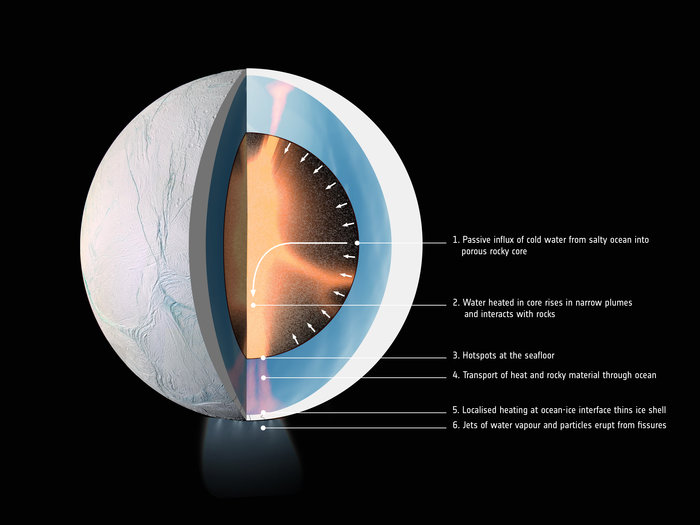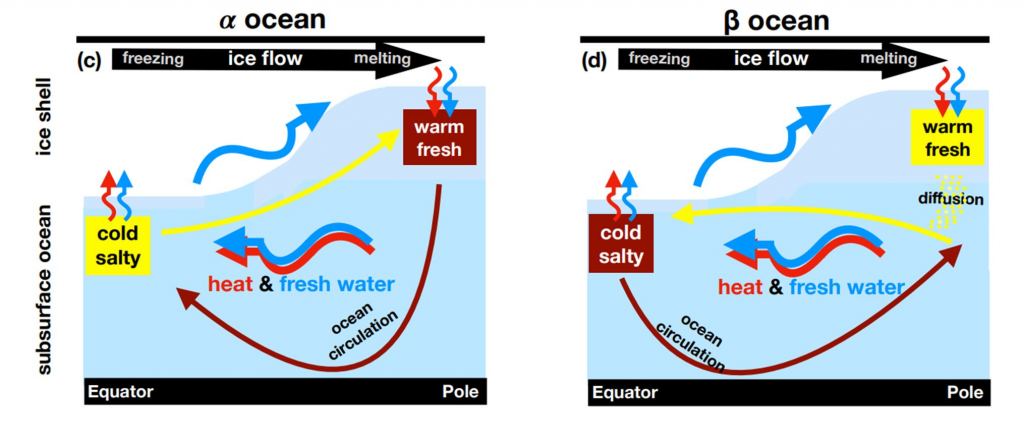An icy satellite of Saturn, Enceladus, has been a subject of increasing interest in recent years since Cassini captured jets of water and other material being ejected out of the south pole of the moon. One particularly tantalizing hypothesis supported by the sample composition is that there might be life in the oceans under the ice shells of Enceladus. To evaluate Enceladus’ habitability and to figure out the best way to probe this icy moon, scientists need to better understand the chemical composition and dynamics of Enceladus’ ocean.
Specifically, an appropriate salinity could be important for habitability. Like the porridge of the Three Bears, the salt level of the water must be just right for life to thrive. Too high a salinity could be threatening to life, and too low a salinity may indicate a weak water-rock reaction, limiting the amount of energy available to life. If life does exist, ocean circulation, which is also indirectly dependent on salinity, will determine where the heat, nutrient and potential biosignatures are transported to, and therefore is the key to the detection of biosignatures.
A team of scientists working with Dr. Wanying Kang at MIT approaches these questions by numerically simulating the likely ocean circulations for various possible levels of salinity and evaluating the likelihood of each scenario by asking whether it is able to maintain the observed ice shell geometry that Cassini mapped out on the icy moon.
Ocean circulation is dependent on differences in density of its constituent water in different parts of the ocean. Water that is more dense will flow toward water that is less dense in order to reach a equilibrium. Those density differences are themselves controlled by two key factors, the location of the moon’s heat source and the ocean salinity, both of which are currently poorly understood.
There are two places on Enceladus for a potential heat source: in the silicate core or in the lower ice shelf where it meets the upper part of the ocean. If a significant amount of heat is produced in the silicate core through tidal flexing underneath the ocean, scientists would expect to see convection, just like what happens when you boil a pot of water. Similarly, if freezing happens atop of the ocean, salt will be expelled out of the ice, increasing the local water density and triggering convection from the top.
Salinity also plays a key role in those density calculations. For relatively low salinity levels, water contracts upon warming near the freezing point, making it more dense. Since Enceladus’ ocean is in contact with a global ice shell, it is near freezing. This is counterintuitive to how most people think of warming – which generally implies that material becomes less dense with increasing temperature. At higher salinities, this becomes true and water starts to behave normally, expanding upon warming.

Given the uncertainty of Enceladus’ ocean salinity (between 4-40 grams of salt per kilogram of water) and what percentage of the planet’s heating takes place at either of the two sources, Dr. Kang and her coauthors utilized MIT’s ocean model to simulate the ocean circulation under various combinations, assuming that the observed ice shell is maintained by freezing in the thick ice regions and melting elsewhere. This largely holds true for icy worlds, as ice shelves would flatten out naturally over time due to ice flow if no other process is maintaining a difference.
The team diagnosed the heat transport under various scenarios and found only a few of them can broadly maintain a “balanced” heat budget, i.e., how the various sources of heat (the amount of heat flux from the ocean to the ice, plus the heat production in the ice due to tidal flexing, plus the latent heat release) can exactly balance the conductive heat loss through the ice shell.

Credit: Kang et all
According to the model, such a balance can be achieved broadly if the ocean salinity is at some intermediate level (10-30 g/kg) and if the ice shell is the dominant heat source. When these two conditions are satisfied, the ocean circulation is weak. As a result, the warm polar water won’t be mixed toward the equator too efficiently, so equatorial melting won’t happen. This results in an ice shelf which is thicker around the equator of the moon, as was observed by Cassini. It also implies that the pressure at the water-ice interface is lower at the poles, meaning it also has a higher freezing point than water at the equator.
For those scenarios with an “unbalanced” heat budget, meaning some of the heat created on the moon isn’t conducted away, the equatorward heat transport is too efficient and the equatorial ice shell will tend to melt. Meanwhile, the pressure gradient force will drive an ice flow from the equator to the poles. Together, the melting and ice flow will reduce the ice thickness near the equator, inevitably. Under this scenario, the observed ice geometry can’t be maintained over the moon’s lifetime.

In the end, the work by Dr. Kang and her colleagues highlights that ice shell and ocean circulation on icy satellites should be considered as a coupled system: ocean circulation redistributes heat and shapes the ice shell, and in turn, the ice shell’s freezing/melting and thickness variation drives the ocean circulation. One nice outcome of this research is that it indicates the possibility to infer one from the other, which can be useful far beyond Enceladus. As part of that effort to understand the icy moons in our solar system, a group known as the Exploring Ocean Worlds program will work together to deepen our understanding on icy moons’ habitability and the optimal way to probe them.
Learn More:
arXiv – How does salinity shape ocean circulation and ice geometry on Enceladus and other icy satellites?
UT – Complex Organics Molecules are Bubbling up From Inside Enceladus
UT – Radioactive Core Might Explain Geysers on Enceladus
Lead Image:
Illustration of the interior of Enceladus – thicknesses not to scale.
Credit: NASA / JPL – Caltech

